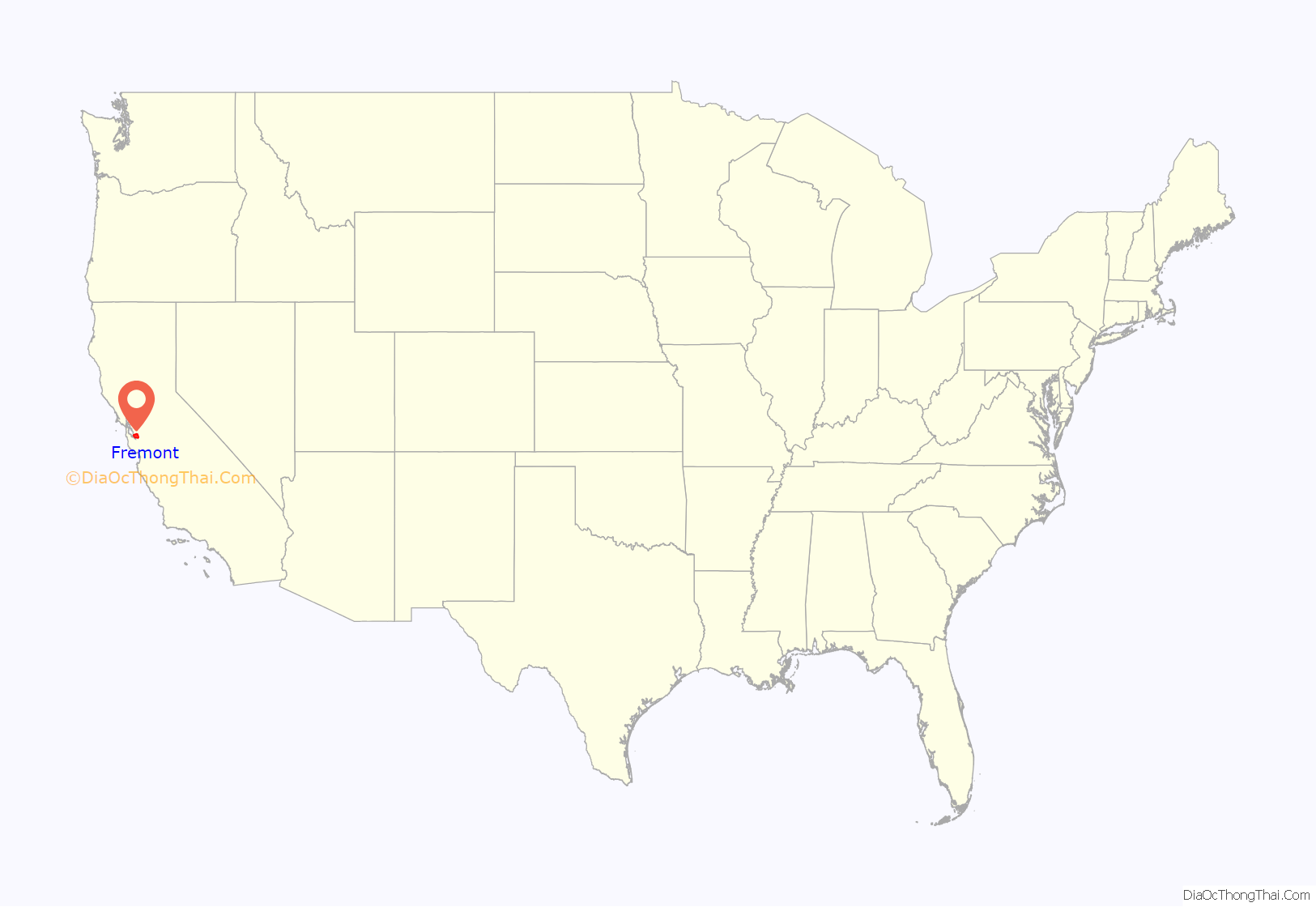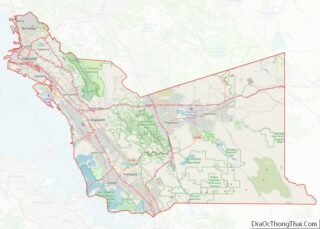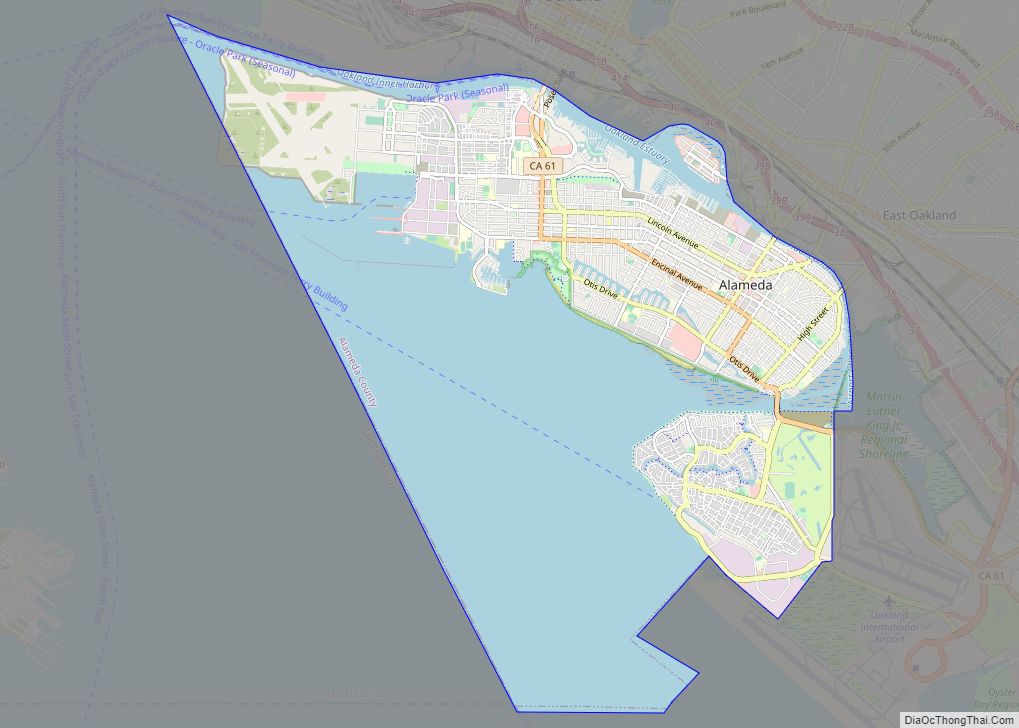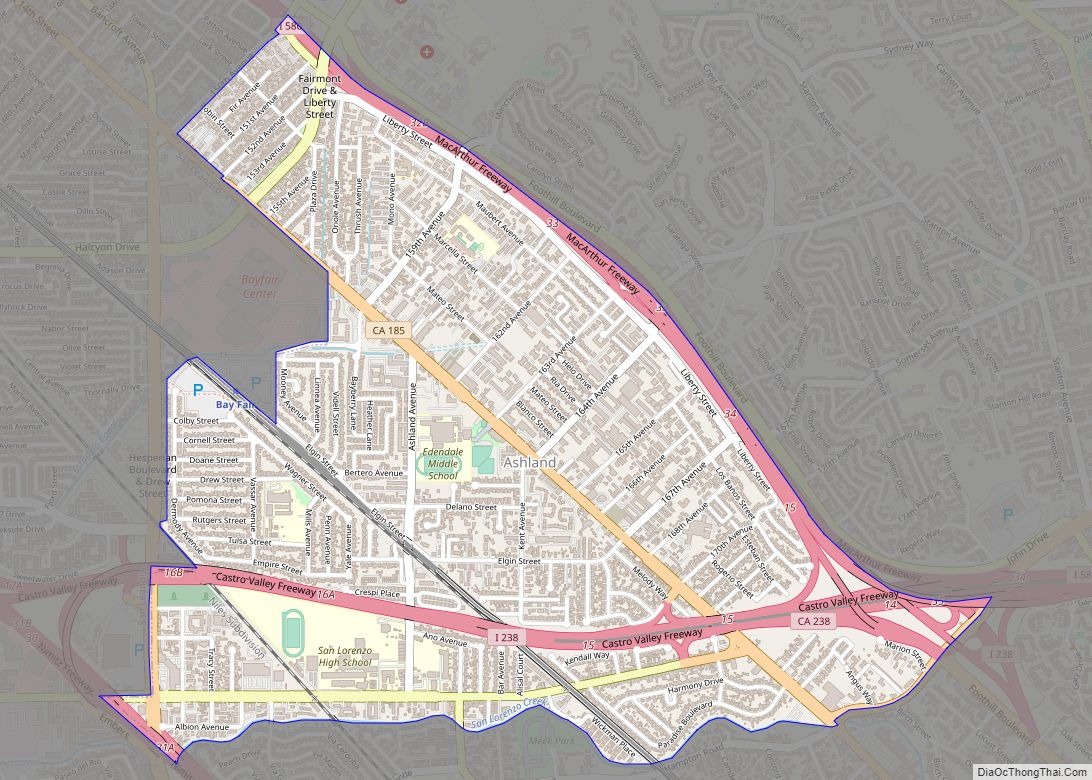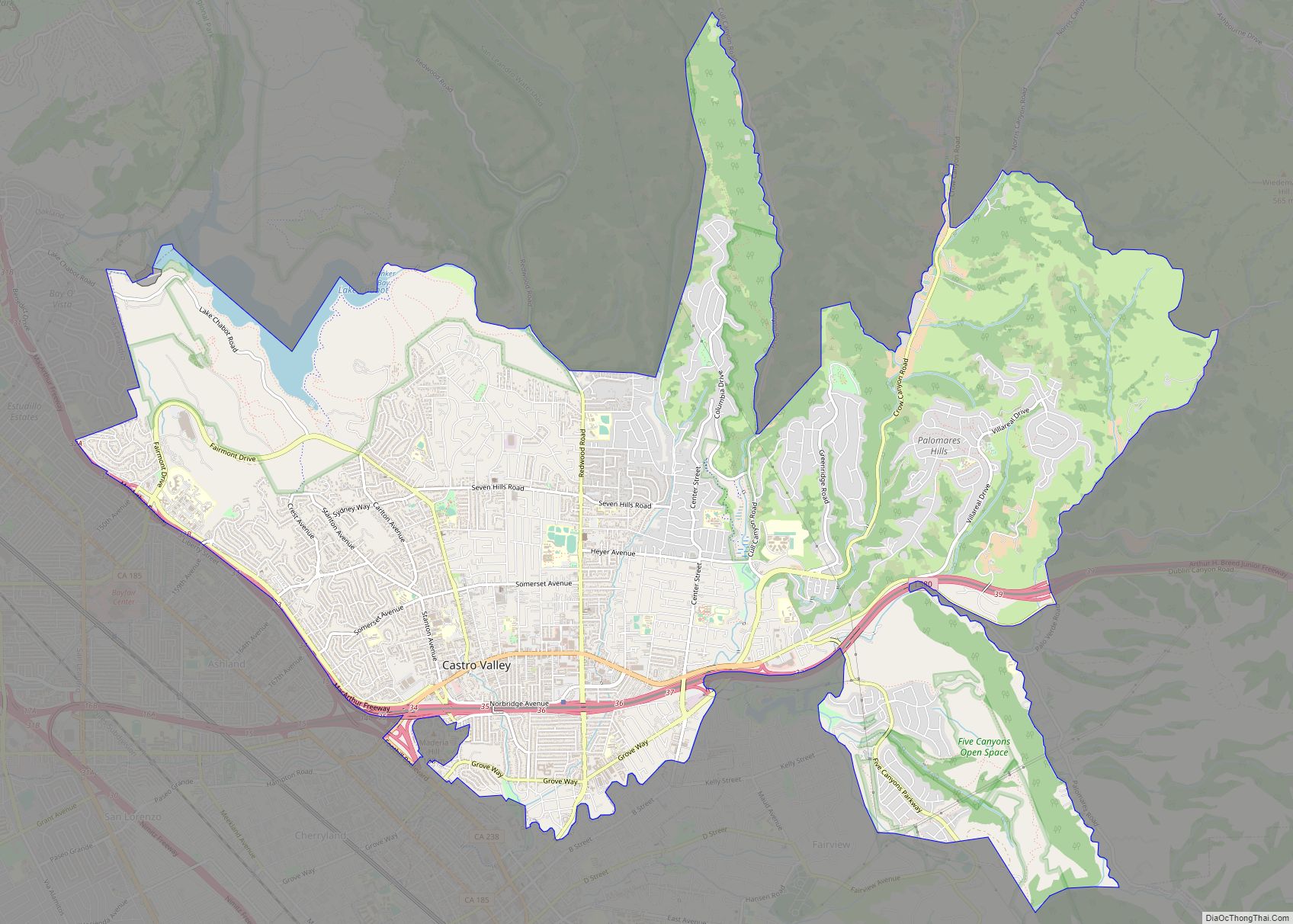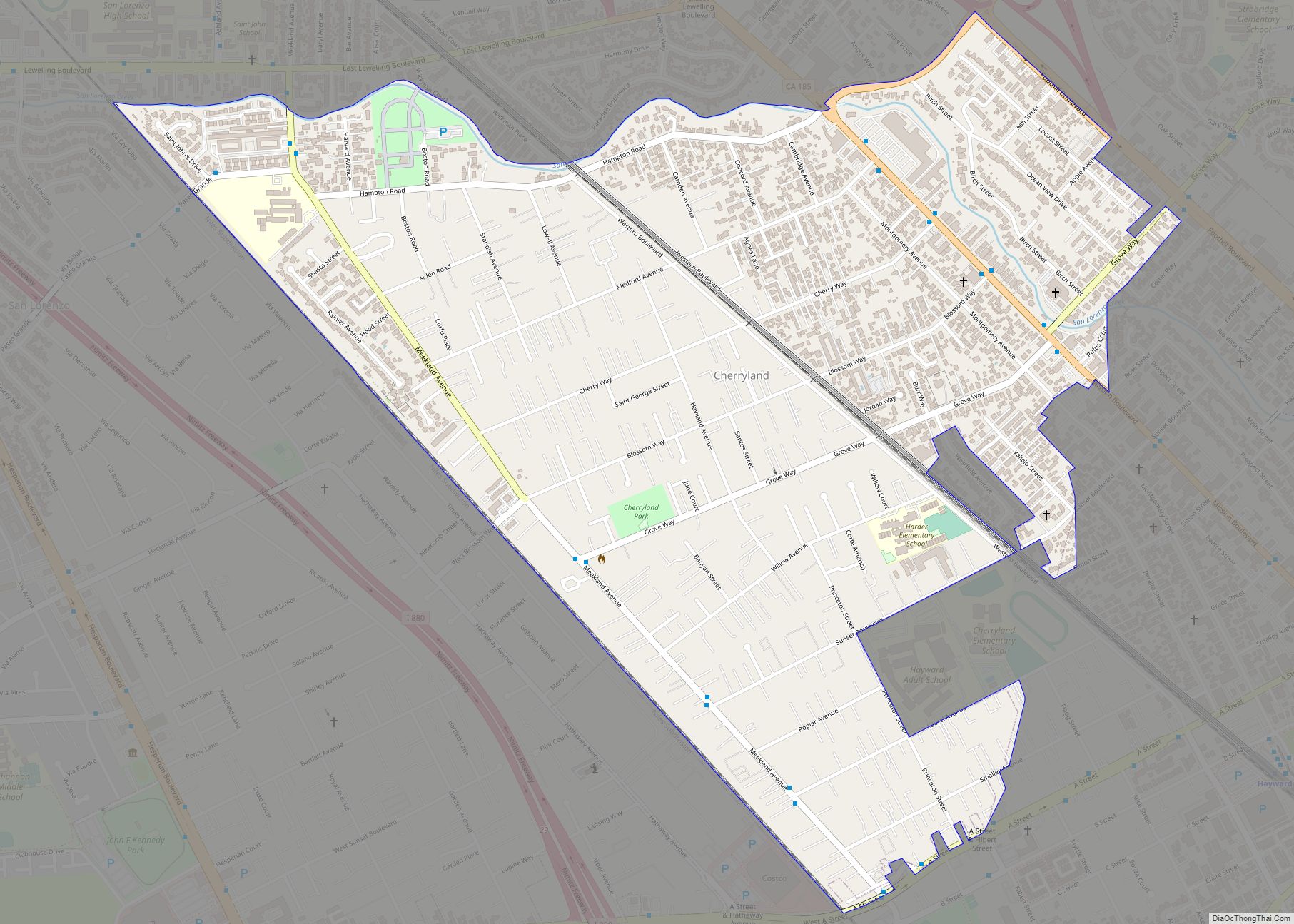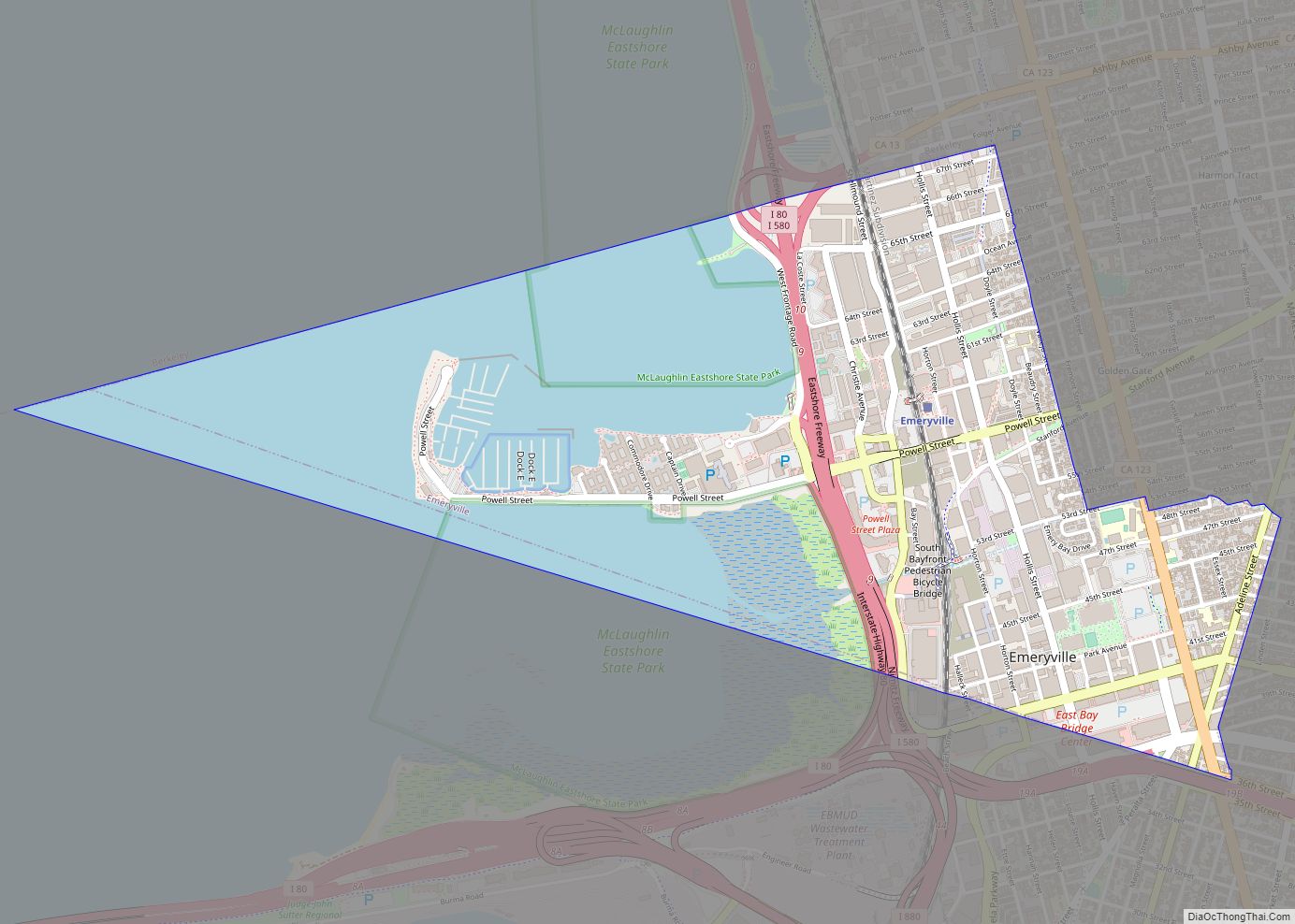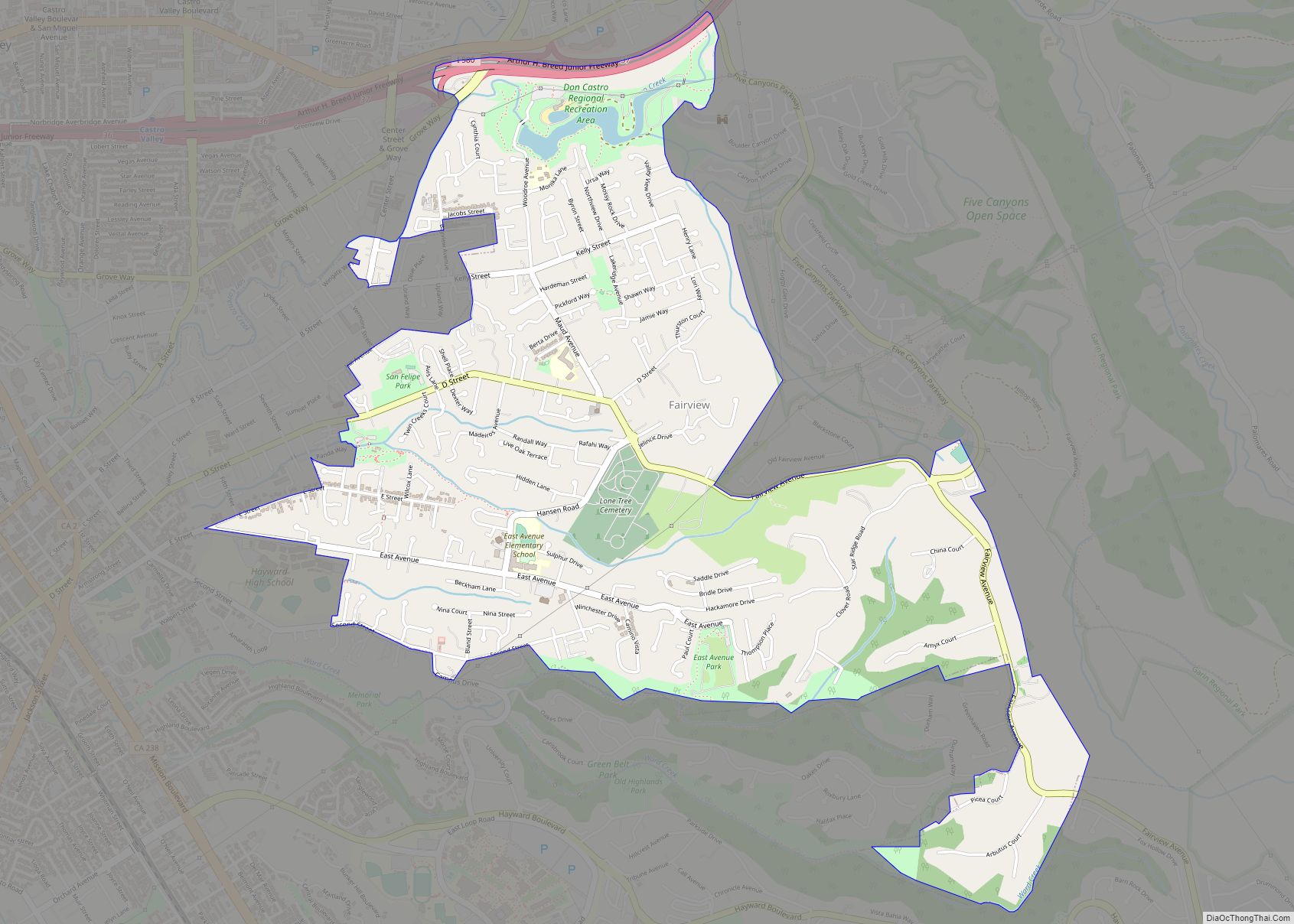| Name: | Fremont city |
|---|---|
| LSAD Code: | 25 |
| LSAD Description: | city (suffix) |
| State: | California |
| County: | Alameda County |
| Incorporated: | January 23, 1956 |
| Elevation: | 56 ft (17 m) |
| Total Area: | 88.46 sq mi (229.10 km²) |
| Land Area: | 78.31 sq mi (202.83 km²) |
| Water Area: | 10.14 sq mi (26.27 km²) 11.6% |
| Total Population: | 230,504 |
| Population Density: | 2,600/sq mi (1,000/km²) |
| ZIP code: | 94536–94539, 94555 |
| Area code: | 510, 341 |
| FIPS code: | 0626000 |
| Website: | www.fremont.gov |
Online Interactive Map
Click on ![]() to view map in "full screen" mode.
to view map in "full screen" mode.
Fremont location map. Where is Fremont city?
History
Early history
The recorded history of the Fremont area began on June 6, 1797, when Mission San José was founded by the Spaniard Father Fermín de Lasuén. The Mission was established at the site of the Ohlone village of Oroysom. The tribe lived between present-day San Francisco and Monterey and more lands towards the East. They lived in dome-shaped shelters made out of redwood bark or woven tule. They were primarily hunter-gatherers; men hunted and trapped waterfowl, rabbits, deer, elk, and bears, whilst women gathered nuts, berries, and root vegetables. The Ohlone tribe lived beside rivers and estuaries because of the natural resources like fish and shellfish. In warm weather, men wore mostly nothing; in the winter, they wore animal hide or feather capes. Other than the weather, ceremonies also decided what the Ohlone men wore. The women wore deerskin aprons over skirts made of tule or shredded bark.
Until 1769, the tribe lived peacefully with their people but Spanish soldiers and missionaries arrived in California to expand Spanish dominion in the Americas and convert the Native Americans to Catholicism. The Ohlone people weren’t intimidated by the Franciscan priests, who welcomed them into their missions to live and work. Before missions, the Natives used tools made of stone, animal bones, and wood. The missionaries taught them how to make metal tools and weapons and priests also showed them how to make adobe bricks. The bricks were then used to build missions rather than for the tribe to utilize. The Spaniards brought cattle, pigs and sheep and encouraged the Ohlone to give up hunting and gathering to try farming and ranching instead. Unfortunately, living in the missions had a negative part to it, which was that the Ohlone people were forced into converting to Christianity and told to forget the superstitious beliefs that connected them to nature. Along with that, overpopulation caused food shortages and the Spanish brought diseases to the tribe, causing a lot of deaths and trouble that made an impact on a lot of lives.
On their second day in the area, the Mission party killed a grizzly bear in Niles Canyon. The first English-speaking visitor to Fremont was the renowned trapper and explorer Jedediah Smith in 1827. The Mission prospered, eventually reaching a population of 1,887 inhabitants in 1831. The influence of the missionaries declined after 1834 when the Mexican government enacted secularization.
José de Jesus Vallejo, brother of Mariano Vallejo, was the grantee of the Rancho Arroyo de la Alameda Mexican land grant. His family was influential in the Fremont area in the late colonial era and owned and built a flour mill at the mouth of Niles Canyon. In 1846 the town’s namesake John C. Frémont led a military expedition to map a trail through Mission Pass for reaching the Pacific coast and to take possession of California from Mexico for the United States.
The Fremont area grew rapidly at the time of the California Gold Rush. A town called Mission San José grew up around the old mission, with its own post office from 1850. Agriculture dominated the economy with grapes, nursery plants and olives as leading crops. In 1868 the 6.8-magnitude Hayward earthquake on the Hayward Fault collapsed buildings throughout the Fremont area, ruining Mission San José and its outbuildings. Until the 1906 San Francisco earthquake caused its destruction, the Fremont area’s Palmdale Winery was the largest in California. The ruins of the Palmdale Winery are still visible near the Five Corners in Irvington. From 1912 to 1915, the Niles section of the Fremont area was the earliest home of California’s motion picture industry (see Essanay Studios). Charlie Chaplin filmed several movies in the Fremont area, most notably The Tramp.
Incorporation
Fremont was incorporated in 1956 under the leadership of Wally Pond, chair of the incorporation committee, when five towns in the area, Irvington, Centerville, Mission San José, Niles, and Warm Springs, came together to form a city. Glenmoor Gardens, the largest subdivision in Fremont, was under construction in the area, by developers Ralph E. Cotter, Jr., James R. Meyer, civil engineer Fred T. Duvall, and contractors James L. Reeder, and Robert H. Reeder. When the Glenmoor Gardens Homeowners Association (GGHA) was incorporated, in March 1953, there were no more than 75 houses in the subdivision. It was probably the first such organization in the Fremont area; in its scope and structure. The five-member board of directors (which included James Meyer and James Reeder) was set up to oversee a full range of services, from police and fire protection to street maintenance (which later became the purview of the city government).
Fremont became more industrialized between 1953 and 1962. A boom in high-tech employment in the 1980s to the late 1990s, especially in the Warm Springs District, caused rapid development in the city and linked the city with the Silicon Valley. The Apple factory where the first Mac computer was manufactured was located in Fremont; production ceased in 1993. Other semiconductor and telecommunications firms soon opened in the city, including Cirrus Logic, Asyst Technologies, Mattson Technology, Lam Research, Premisys Communications, and Nextlink California. Approximately 750 high tech companies had offices, headquarters or production facilities in Fremont by 1999. These firms included fifteen of the top one hundred fastest-growing public companies in the San Francisco Bay Area and eighteen of the top fifty companies in the East Bay. The high-tech growth in Fremont continues today and is a major industry for the city.
The General Motors automotive assembly plant in South Fremont was the town’s largest employer, and Fremont was known for its drag strip. In the 1980s, the plant became a joint venture automotive assembly plant of Toyota and General Motors, and was renamed NUMMI. Toyota and NUMMI shut down its operations in early 2010. Part of the plant was acquired in June 2010 by Tesla Motors as its primary production plant, known as the Tesla Factory.
Solyndra, a solar panel manufacturer, was promoted in 2010 by President Barack Obama as a model for government investment in green technology after his administration approved a $535-million Department of Energy loan guarantee and the company built a $733 million state-of-the-art robotic facility, but in 2011 the company filed for Chapter 11 bankruptcy and laid-off 1,000 workers. Data storage company Seagate Technology, incorporated in the Republic of Ireland with executive offices in Cupertino, acquired the former Solyndra building, which serves as Seagate’s headquarters since 2020.
The first Fremont post office opened in 1956.
Fremont Road Map
Fremont city Satellite Map
Geography
In 1956, five small, independent towns (Centerville, Niles, Irvington, Mission San José, and Warm Springs) located between the East Bay rolling hills and the San Francisco Bay were annexed into a single new, incorporated city called Fremont. Six decades later, these places have greatly expanded, are no longer separate communities, and are considered districts or community plan areas of the City of Fremont. The town of Newark was originally slated to join the annex, but ultimately its voters declined since Newark representatives suspected that they would become an industrial district; Newark became its own incorporated city in 1955. Later, Newark annexed a patch of unincorporated land between Mowry Avenue and Stevenson Blvd; Land which is now occupied by Newpark Mall and the surrounding plazas. Since incorporation, Fremont has created six more districts, which it calls “community plan areas” for planning purposes. These include Central, North Fremont, South Fremont, and Bayside. The two other districts, Baylands and the Hill Areas, are primarily open space.
The area consisting of Fremont and the cities of Newark and Union City is known collectively as the Tri-City Area (different from the adjacent Tri-Valley area encompassing Pleasanton, Dublin, and Livermore).
Centerville District
Centerville was the main town in Washington Township. Centerville is located at 37°33′15″N 121°59′57″W / 37.55417°N 121.99917°W / 37.55417; -121.99917 (Centerville). It lies at an elevation of 52 feet (16 m). Centerville was started by George Lloyd who started selling cold beer to stage passengers from a tent in 1850. Capt. George Bond set up a general store and the name Centerville was chosen. The post office opened Centreville post office in 1855 and changed the spelling to Centerville in 1893. The Centerville Pioneer Cemetery contains the burial places of many of the city’s founding pioneers.
Centerville can be traced back to its native American roots. Spanish, Mexican, Italian, Portuguese and Swiss (Swiss Park), peoples were among the early settlers that contributed greatly to the growth of Centerville.
Early Centerville was a quiet farming community, which consisted of large Spanish land grants divided into smaller farms. The Freitas Ranch on Thornton Ave was probably the largest of the working farms. There were acres of apricot along with other fruit and nut orchards and large fields of various types of fresh produce.
After President Roosevelt issued Executive Order 9066, which authorized military commanders to exclude “any or all persons” from certain areas in the name of national defense, the Western Defense Command began ordering Japanese Americans living on the West Coast to present themselves for “evacuation” from the newly created military zones. This included many Centerville farming families.
Centerville was also a main stop for the early railways. This gave the local farmers a way to quickly get their produce to market. With the access to railway service there was once a large cannery on Baine Ave. west of Fremont Ave. (now Peralta) next to the tracks. In 1959, the cannery was destroyed in the largest fire in Fremont’s history. The fire lasted for two days, and effectively put an end to what had been the largest employer in Centerville at the time. The cannery was never rebuilt.
Housing developments began to appear in the area after WWII. Most of the early housing stood along Fremont Blvd from Decoto Road south to Washington High school, along Thornton Ave from Fremont Blvd west to the Newark city border, and along Peralta Blvd from Fremont Blvd to Niles.
For city planning purposes, Centerville was enlarged to encompass most of the north central residential section of Fremont, from Mowry Ave to Decoto Rd, from I-880 to the BART line. This Centerville community plan area includes the sprawling subdivisions, developed in the 1950s and 1960s, of Glenmoor Gardens, bounded by Central Avenue, Fremont Boulevard, Mowry Avenue, and the I-880 freeway. and the Cabrillo Park subdivision bound by Thornton Ave, Fremont Blvd, Decoto Road and the I-880 freeway. Also the Brookvale subdivisions, the Quarry Lakes Regional Park, and part of Parkmont. The area is served by two high schools, Washington High School (Fremont, California) established in 1892, which for a long time was the only high school in the area and American High School established in 1972. It also has two junior high schools, Centerville Junior High School and Thornton Junior High School, which now stands on the old main site of the Freitas ranch.
Niles District
The town is physically divided from other parts of Fremont and neighboring Union City by Mission Boulevard (State Route 238) to the east and north, Alameda Creek to the south, Union Pacific Railroad to the west and southeast, and the Quarry Lakes to the southwest. The hills of Niles are lower than those of the area south of the Alameda Creek in Mission San Jose. Old Town Niles features its own library, post office, and silent movie theater as well as a large number of antique and craft stores. Niles is located at 37°34′44″N 121°58′40″W / 37.57889°N 121.97778°W / 37.57889; -121.97778 (Niles District). It lies at an elevation of 112 feet (34 m).
The community, once called Vallejo Mills, got its name from the Central Pacific Railroad’s Niles depot, built in 1870 as part of the First transcontinental railroad and named after their railroad attorney and stockholder Addison Niles, who became associate justice on the California Supreme Court two years later. A post office was opened at Niles in 1873.
Niles was the home of one of the first West Coast motion picture companies, Essanay Studios. Charlie Chaplin and Broncho Billy Anderson filmed some of their most famous silent movies in Niles. Scenic Niles Canyon stretches between Niles and Sunol. The nonprofit Niles Essanay Silent Film Museum offers both artifacts of Niles’ early years and each Saturday evening, screenings of early-twentieth-century silent films, many of which were filmed locally.
The Niles Canyon Railway runs along Alameda Creek in Niles Canyon and carries passengers on weekend excursions, including a holiday “train of lights”, which is extremely popular – tickets for these trains typically sell out by early October. The Niles Canyon Railroad has a small but well-maintained collection of historic rail stock.
Part of historic Niles is Mayhew Spring, also known as Mayhew’s Sulphur Spring, which was located 600 feet (180 m) north of the Niles railroad depot. The facility was owned by H.A. Meyhew. The coast-to-coast completion of the Transcontinental Railroad is reported to have occurred in nearby Niles Canyon. In September 1869, four months after the famous golden spike ceremony at Promontory Summit, Utah, the Central Pacific Railroad completed the transcontinental rail link between Sacramento and the San Francisco Bay, finishing the track through the canyon. The Central Pacific had acquired the Western Pacific and other local railroads and built track to connect them at a waterfront terminal at Alameda Point.
Also part of Niles is Niles Junction on the Western Pacific Railroad, located at 37°34′35″N 121°58′17″W / 37.57639°N 121.97139°W / 37.57639; -121.97139 (Niles Junction WPRR) and situated at an elevation of 79 ft (24 m).
Irvington District
The Irvington District area has cycled through many name changes over time. In the early 1850’s two emancipated black men were traveling with E.L. Beard through California, reputedly in search of a fortune. The former slaves noticed the busy traffic at the crossroads of what is today the “Five Corners” intersection. Although now gone, there were two embarcaderos (water crossings) at this area. One of these crossings had a ferry. Realizing the financial opportunity of the area, the former slaves constructed the first building at the cross roads, a tavern with an inn. This tavern was later known as Dave’s Saloon. This corner, today the intersection of Fremont and Washington Boulevards, Union and Bay Streets, is now commonly known as “Five Corners” or Irvington Square. Irvington Square’s marker, Irvington Plaza park, is located at 37°31′22″N 121°58′18″W / 37.52278°N 121.97167°W / 37.52278; -121.97167 (Irvington Square). The inn and several of the other original buildings were demolished by the city of Fremont in the early 1980s. During the 1850’s until re-designated in 1871 by the U. S Post Office, the cross roads were locally known as “Niggers Corners”. In 1871 Washington College, the first industrial educational institution in California was established in Washington township near the crossroads. As a result, the US Postal Service established a post office called Washington Corners at the college in 1870, which became the name of the settlement on the 1878 Alameda County map of Washington Township.
In 1884, realizing the need for a proper town name, local inhabitants selected the name of Irving. The name was chosen in honor of Judge Irving, the local traveling circuit judge of the time. Later, when the railroad came through the area, the published train schedule pamphlets erroneously listed the Irving train depot as “Irvington.” The town petitioned the railroad about the error. The railroad company notified the town that it was too costly for them to replace the train schedule pamphlets (over $100,000); and in 1887 following the recommendation, the people of Irving changed the town name to Irvington.
The Irvington district has two main neighborhoods: Irvington Woods and the Irvington Square. The neighborhood is ethnically mixed and is primarily working class. For city planning purposes, the Irvington area was enlarged to encompass most of the south central residential section of Fremont, from Auto Mall Parkway to Mowry Avenue, from I-880 to roughly the BART line (excluding the Central District described below). This Irvington community plan area includes the Sundale neighborhood, the South Sundale neighborhood, 28 Palms, Blacow, and Grimmer subdivisions. The area is served by three high schools: Irvington High School, Robertson High School, and John F. Kennedy High School.
The Irvingtonian period of North American mammals is named for this district due to the fossil sequence excavated here.
Mission San Jose District
At the time of the California Gold Rush, a boom town grew up around the old Mission, to equip and transport 49ers overland to the gold fields. A post office was opened at Mission San Jose in 1850.
The district, like Niles, is surrounded by hills. The hills are higher and steeper than Niles, with the highest points being on the Mission Ridge. Mission San Jose district lies close to the northern two peaks, Mission Peak and Mount Allison. Mission Peak is very distinctive and is one of Fremont’s emblems. These peaks go from 2,517 to 2,604 ft (794 m), taller than Mount Tamalpais, a great height for the San Francisco Bay Area. They see some deep snow occasionally.
Fremont’s community college, Ohlone College, is situated one block away from the mission and serves over 12,000 students.
Mission San Jose has the highest concentration of Asian Americans in Fremont – over 50% of the population as of the 2000 census. The local high school is Mission San Jose High School, ranked 67 in the nation by U.S. News & World Report. The median family income for the Mission San Jose area (ZIP code 94539) exceeded $114,595 in 2005. Owing to an influx of professionals and other affluent families seeking access to the top-performing local public schools, Mission San Jose’s median home value reached $831,000 in 2006, earning the community a rank of 237 on Forbes magazine’s list of the 500 most affluent communities in the United States.
In 2001 an attempt by community organizations in the Mission San Jose district to withdraw from the Fremont Unified School District caused state-wide controversy and led to accusations of racism from both sides. The attempt was prompted by a re-drawing of the school enrollment areas, under which some Mission San Jose residents would send their children to Horner Junior High and Irvington High schools. The controversial effort to secede was dropped later that year. Fremont’s public schools continue to rank among the best in California.
Nestled at the base of Fremont’s rolling hills is the Mission San José, one of the oldest of the historic Spanish missions in California, for which this district is named. The church building that exists today is a re-construction (dedicated in 1985 for daily Mass and tours) of the original 1809 adobe church that was destroyed by the 1868 Hayward-fault earthquake. One side of the original mission quadrangle remains and houses a museum. Mission San Jose is located at 37°31′59″N 121°55′13″W / 37.53306°N 121.92028°W / 37.53306; -121.92028 (Mission San Jose); and lies at an elevation of 305 feet (93 m).
Warm Springs District
Warm Springs is located on Rancho Agua Caliente and is so named for the springs that are located there. In early times, there was a settlement called Harrisburgh (also, Harrisburg and Peacock’s) a short distance east from the small settlement of Warm Springs. A post office opened in Harrisburgh in 1865 and changed its name to Warm Springs in 1885. The name Harrisburgh commemorated Abram Harris, who settled there in 1858. The name Peacock’s commemorated George W. Peacock, its first postmaster. The post office name changed to Warmsprings in 1895 and reverted to Warm Springs in 1950.
The Warm Springs district is the southernmost portion of Fremont whose hub is the Warm Springs and Mission Boulevard intersection. It is located at 37°29′14″N 121°55′45″W / 37.48722°N 121.92917°W / 37.48722; -121.92917 (Warm Springs), and lies at an elevation of 62 feet (19 m). Warm Springs has attracted the headquarters of many high-tech companies including Nielsen Norman Group, Lam Research, Corsair and Lexar of the US as well as foreign high-tech companies such as Elitegroup Computer Systems, and Asus. The district is also home to blue-collar industry. The San Jose mission is also present.
Warm Springs also serves as commercial center for the mainly residential Mission San Jose district, especially since the construction of Pacific Commons, a large, modern regional shopping center. The Oakland Athletics talked about moving their stadium to this area. Warm Springs was home to one of the SF Bay Area’s only two coffee houses to employ baristas who wear bikinis, Your Coffee Cups, a concept that’s gained some controversy from Bay Area newspapers and news stations. This controversy led to the eventual closing of the business.
The BART extension to Warm Springs began construction in 2009 and Warm Springs/South Fremont station opened for service on March 25, 2017.
Central district
The central district is surrounded by the Centerville, Niles, Mission San Jose, and Irvington communities. The central district contains retail shopping centers (e.g., the Fremont Hub), the Fremont Bay Area Rapid Transit station, health care centers and Central Park (Lake Elizabeth).
City planners envision a mid-density, pedestrian friendly, transit oriented development, bounded by Mowry Ave, Fremont Blvd, Walnut Ave, and Paseo Padre Pkwy. One of the central streets, the Capital Avenue extension to Fremont Blvd, was completed in 2016, as the city pursues its plans for a Downtown Fremont Archived December 24, 2014, at the Wayback Machine.
Most of Fremont is part of the Laguna Creek Watershed.
North Fremont District
North Fremont is a primarily residential district surrounded by Union City, Centerville District, Newark, and Coyote Hills Regional Park. It is a growing community that includes the Ardenwood neighborhood, the Lakes and Birds neighborhood, and the Northgate neighborhood. It is the site of the Ardenwood Historic Farm, which has the George Washington Patterson House as one of its highlights, and the Ardenwood Technology Park. A 99 Ranch Market is one of many Asian businesses in the North Fremont District. Thornton Junior High School and American High School, which are both physically located in the enlarged Centerville District, also serve as the junior high and high school, respectively, for this community.
South Fremont District
South Fremont is a primarily industrial district, east of Interstate 880 and west of Interstate 680, south of Auto Mall Parkway and north of Brown Rd. The area overlaps with Warm Springs, with which it shares the eponymous BART station. The composition of the area will change, because thousands of residential units were under construction as of 2016. It is sandwiched between the Irvington and Warm Springs community plan areas. It is noted as the site of the Tesla Factory as well as the site of the Warm Springs / South Fremont BART station. In 2022, a pedestrian bridge was built from the BART station to Lopes Court. It costed $41 million.
Bayside Industrial District
Bayside Industrial is a primarily industrial and commercial district, west of Interstate 880 between Newark and Milpitas.
Hill Area District
Hill Area is an open land district that forms the eastern edge of Fremont. It is the site of Mission Peak.
Climate
Fremont has a warm-summer Mediterranean climate (Köppen: Csb) typical of the San Francisco Bay Area. This climate features warm, dry summers and cool, wet winters. Like nearby San Jose, precipitation is fairly low (about 17 inches per year) because the city lies in the rain shadow of the Santa Cruz Mountains to the west. The lowest temperature recorded was 21 °F (−6 °C) on December 23, 1990.
See also
Map of California State and its subdivision:- Alameda
- Alpine
- Amador
- Butte
- Calaveras
- Colusa
- Contra Costa
- Del Norte
- El Dorado
- Fresno
- Glenn
- Humboldt
- Imperial
- Inyo
- Kern
- Kings
- Lake
- Lassen
- Los Angeles
- Madera
- Marin
- Mariposa
- Mendocino
- Merced
- Modoc
- Mono
- Monterey
- Napa
- Nevada
- Orange
- Placer
- Plumas
- Riverside
- Sacramento
- San Benito
- San Bernardino
- San Diego
- San Francisco
- San Joaquin
- San Luis Obispo
- San Mateo
- Santa Barbara
- Santa Clara
- Santa Cruz
- Shasta
- Sierra
- Siskiyou
- Solano
- Sonoma
- Stanislaus
- Sutter
- Tehama
- Trinity
- Tulare
- Tuolumne
- Ventura
- Yolo
- Yuba
- Alabama
- Alaska
- Arizona
- Arkansas
- California
- Colorado
- Connecticut
- Delaware
- District of Columbia
- Florida
- Georgia
- Hawaii
- Idaho
- Illinois
- Indiana
- Iowa
- Kansas
- Kentucky
- Louisiana
- Maine
- Maryland
- Massachusetts
- Michigan
- Minnesota
- Mississippi
- Missouri
- Montana
- Nebraska
- Nevada
- New Hampshire
- New Jersey
- New Mexico
- New York
- North Carolina
- North Dakota
- Ohio
- Oklahoma
- Oregon
- Pennsylvania
- Rhode Island
- South Carolina
- South Dakota
- Tennessee
- Texas
- Utah
- Vermont
- Virginia
- Washington
- West Virginia
- Wisconsin
- Wyoming
